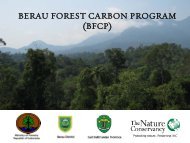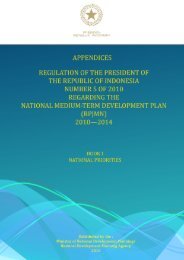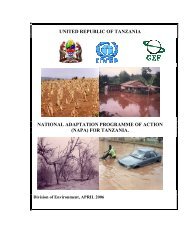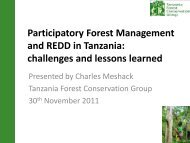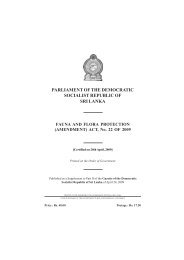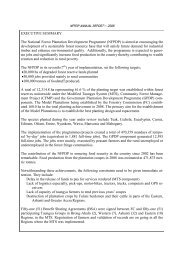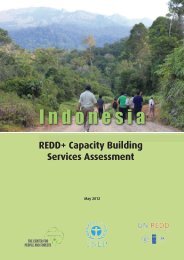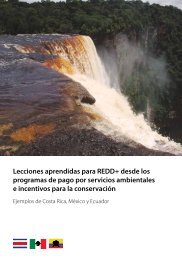forest policy 2007.pdf
forest policy 2007.pdf
forest policy 2007.pdf
You also want an ePaper? Increase the reach of your titles
YUMPU automatically turns print PDFs into web optimized ePapers that Google loves.
Republic of Kenya——————MINISTRY OF ENVIRONMENT AND NATURAL RESOURCESSessional Paper No. 1 of 2007onForest PolicyPRINTED BY THE GOVERNMENT PRINTER, NAIROBI
Sessional Paper No. 1 of 2007onForest Policy
Table of Contents4.2 Forestry Research and Education.....................................184.3 Forest User Rights and Livelihoods.....................................194.4 International Obligations....................................................194.5 Gender and youth Issues...................................................204.6 Non-State Actors .................................................................214.7 HIV/AIDS................................................................................21© 2007 Government of Kenya iii
ForewordFOREWORDThe Forest Sector plays vital roles in the livelihood of theKenyan population through provision of invaluable <strong>forest</strong>related goods and services. The most significantcontribution is in the energy supply for domestic andindustrial processes, provision of timber for constructionand trees for regulation of water flow. It is estimated that80% of the population use biomass energy while urbandevelopment and hydro energy rely heavily on water.Forests will continue to provide essential goods andservices such as timber, poles, fuel-wood, food, medicines,fodder and other non-wood <strong>forest</strong> products. Forestresources and <strong>forest</strong>ry development activities alsocontribute significantly to the national economy bysupplying raw materials for industrial use and creatingsubstantial employment opportunities and livelihoods.As important as our <strong>forest</strong>s are to the national economy, theirsustainable development and management continues to behampered by a number of factors, including inadequatefinancial resources and the lack of an enabling <strong>policy</strong> andlegislation. In addition, the increasing population and povertycontinue to exert pressure on the country’s <strong>forest</strong> resources.This pressure is witnessed in the current rampant illegallogging, illegal charcoal making and encroachment foragriculture and settlement. These challenges haveundermined the Government’s efforts in achievingsustainable <strong>forest</strong> management.Kenya is internationally considered to be a low <strong>forest</strong> covercountry as it has less than 10% of its total land area classified as<strong>forest</strong>. The Government will therefore put in place measures tosignificantly increase the area under <strong>forest</strong> cover, with the aimof attaining at least 10% within the next decade. To attain thislevel of <strong>forest</strong> cover, the Government will promote farm<strong>forest</strong>ry, intensify dryland <strong>forest</strong> management, involve theprivate sector in the management of industrial plantations andalso promote community participation in <strong>forest</strong> managementand conservation.© 2007 Government of Kenya iv
ForewordThe key elements of the new <strong>policy</strong> are:-1. A new <strong>forest</strong> legislation to implement the <strong>policy</strong>.2. Expanded mandate in the management of all types of<strong>forest</strong>s.3. Involvement of <strong>forest</strong> adjacent communities and otherstakeholders in <strong>forest</strong> management and conservation.4. Forest management planning will be based on an ecosystemapproach.5. Appropriate incentives will be provided to promotesustainable use and management of <strong>forest</strong> resources.6. Proposed institutional transformation of the ForestDepartment into a semi-autonomous Kenya ForestService.This <strong>policy</strong> will address local and global <strong>forest</strong>ry issues andchallenges to ensure fair contribution of the <strong>forest</strong>ry sector ineconomic development. The implementation of this <strong>policy</strong> isexpected to improve the social welfare of the Kenyanpopulation without compromising environmental conservation.HON. PROF. KIVUTHA KIBWANA, EGH, MPMINISTER FOR ENVIRONMENT AND NATURAL RESOURCES© 2007 Government of Kenya v
IntroductionThe new Forest Policy will address indigenous <strong>forest</strong>management, farm <strong>forest</strong>ry, industrial <strong>forest</strong> development,dryland <strong>forest</strong>ry, <strong>forest</strong> health and protection, private sectorinvolvement and participatory <strong>forest</strong> management. Itrecognizes that there are benefits arising from involvement oflocal communities and other stakeholders in <strong>forest</strong>management. The new <strong>policy</strong> will mainstream the <strong>forest</strong>rysector in economic recovery and enable it to contributesignificantly to poverty alleviation strategies.Most importantly, the new <strong>policy</strong> emphasises the importance of<strong>forest</strong>s for water and biodiversity conservation and for theprovision of woodfuel, cost and benefit sharing.© 2007 Government of Kenya 2
POLICY GOALPolicy Goal and Specific ObjectivesThe goal of this Policy is to: enhance the contribution of the<strong>forest</strong> sector in the provision of economic, social andenvironmental goods and services.SPECIFIC OBJECTIVESThe specific objectives of this <strong>policy</strong> are to: -1. Contribute to poverty reduction, employment creationand improvement of livelihoods through sustainable use,conservation and management of <strong>forest</strong>s and trees;2. Contribute to sustainable land use through soil, waterand biodiversity conservation, and tree planting throughthe sustainable management of <strong>forest</strong>s and trees;3. Promote the participation of the private sector,communities and other stakeholders in <strong>forest</strong>management to conserve water catchment areas,create employment, reduce poverty and ensure thesustainability of the <strong>forest</strong> sector;4. Promote farm <strong>forest</strong>ry to produce timber, woodfuel andother <strong>forest</strong> products;5. Promote dryland <strong>forest</strong>ry to produce woodfuel and tosupply wood and non-wood <strong>forest</strong> products;6. Promote <strong>forest</strong> extension to enable farmers and other<strong>forest</strong> stakeholders to benefit from <strong>forest</strong> managementapproaches and technologies; and7. Promote <strong>forest</strong> research, training and education toensure a vibrant <strong>forest</strong> sector.© 2007 Government of Kenya 3
Sustainable Management of Forests and treesCHAPTER 11. SUSTAINABLE MANAGEMENT OF FORESTS AND TREES1.1 General Management ChallengesForests and trees are renewable resources, which if managedsustainably can meet the demand for raw materials for woodbasedindustries, fuel wood and a wide range of non-wood<strong>forest</strong> products. In addition, they are important for ecologicaland social-cultural values.Forest management has previously emphasized utilizationwith little regard to sustainability particularly with regard toindigenous <strong>forest</strong>s. Industrial <strong>forest</strong> plantations, trees on farms,and <strong>forest</strong>s on local authority lands are also inadequatelymanaged. A general challenge is the acquisition ofinformation and creation of standards that will enablesustainable <strong>forest</strong> management to be monitored over time.Similarly, valuation of resources and products has notreflected the whole range of associated production andreplacement costs and the benefits foregone. This is key inproviding the necessary data for rational resource allocationand planning in the <strong>forest</strong>ry sector. As a management tool, ithas largely been ignored to the detriment of sustainable <strong>forest</strong>management, particularly against land-use changes. While thepotential sustainable yields of wood and other <strong>forest</strong> productsand services have not been achieved in various types of<strong>forest</strong>s, the demand for various <strong>forest</strong> -based products keepson increasing, especially fuel wood.Indigenous <strong>forest</strong>s are among the most complex ecosystemsthat need efficient management. Likewise, challengespresented by fragile and threatened ecosystems, including<strong>forest</strong>s and other woody vegetation types in the arid andsemi-arid lands (ASALS), bamboo <strong>forest</strong>s, and mangroves,require special attention. Forest protection against pests,diseases, fires, and illegal human activities have been ofconcern and this will require to be addressed.Forest management techniques for sustainable production ofwood and other tree-based products and services, and thescientific basis underlying them, are well known, especially forplantation and farm <strong>forest</strong>ry. Efficient application of existing© 2007 Government of Kenya 4
Sustainable Management of Forests and treesknowledge has the potential to enhance <strong>forest</strong> production.Appropriate planning, management, and conservationmeasures require reliable databases on <strong>forest</strong> resources andtheir utilization. Aspects of wildlife management need to beincorporated into <strong>forest</strong>ry management by establishing andstrengthening appropriate inter-agency linkages. The current<strong>forest</strong> <strong>policy</strong> and institutional arrangement have resulted in alimited achievement of set objectives. Further, this <strong>policy</strong> wasnot supported by appropriate legislation. This allowedinappropriate <strong>forest</strong> management practices to creep in. Formore efficient <strong>forest</strong> management, the new <strong>policy</strong> willempower local communities to take an active role in <strong>forest</strong>management through community <strong>forest</strong> associations. Further,the private sector will be encouraged to invest in commercial<strong>forest</strong>ry activities, through leasing, agreements andconcessions. To overcome the current <strong>forest</strong> managementchallenges, the Government will:Policy statement 1.1.1: Promote the sustainablemanagement of <strong>forest</strong>s for climate amelioration, soil, waterand biodiversity conservation.Policy statement 1.1.2: Carry out inventories and valuationof <strong>forest</strong> resources and their utilization to generate accurateinformation for decision making.Policy statement 1.1.3: Empower local communities tomanage <strong>forest</strong>s through community <strong>forest</strong> associations.Policy statement 1.1.4: Ensure that <strong>forest</strong> plantations aresustainably managed to realize their maximum potential.Policy statement 1.1.5: Support <strong>forest</strong> management, whichwill embrace preservation of religious and cultural sites,traditional medicinal sources, water catchments, andhabitats for endemic and threatened species of flora andfauna.Policy statement 1.1.6: Support the formulation of criteriaand indicators for sustainable <strong>forest</strong> management.Policy statement 1.1.7: Promote good governance in the<strong>forest</strong> sector.1.2 Indigenous ForestsKenya's indigenous <strong>forest</strong>s represent some of the most diverseecosystems found anywhere in the world. These <strong>forest</strong>s supply© 2007 Government of Kenya 5
© 2007 Government of Kenya 6Sustainable Management of Forests and treesimportant economic, environmental, recreational, scientific,social, cultural and spiritual benefits. However, some of these<strong>forest</strong>s have been subjected to land use changes such asconversion to farmlands, ranches and settlements. This hasreduced the ability of these <strong>forest</strong>s to supply <strong>forest</strong> products,serve as water catchments, biodiversity conservation reservoirs,wildlife habitats and carbon sinks.Sustainably managed indigenous <strong>forest</strong>s can supply goods andservices to meet the demand of the growing population. These<strong>forest</strong>s will be put under efficient and sustainable multipurposemanagement, which combines biodiversity conservation andwater-catchment functions together with the production oftangible benefits for <strong>forest</strong> adjacent communities. In doing so,<strong>forest</strong> principles will be employed to ensure application ofscience in <strong>forest</strong> management. Revenues accrued throughcommercial <strong>forest</strong> activities will support the management andconservation of indigenous <strong>forest</strong>s. The indigenous <strong>forest</strong>smultiple functions in biodiversity conservation and provision ofgoods and services requires that :Policy statement 1.2.1: All existing indigenous <strong>forest</strong> reserveson public lands remain reserved.Policy statement 1.2.2: The status of indigenous <strong>forest</strong>s will bedetermined and appropriate restoration measures taken.Policy statement 1.2.3: All reserved <strong>forest</strong>s will be managedon the basis of approved management plans, guided bysound <strong>forest</strong> management principles.Policy statement 1.2.4: Participatory <strong>forest</strong> managementapproaches be promoted to ensure the participation ofcommunities and other stakeholders in the management ofindigenous <strong>forest</strong>s.Policy statement 1.2.5: Users of benefits derived from these<strong>forest</strong>s contribute to their conservation and managementthrough the user pay principle.Policy statement 1.2.6: Insect farming and other sustainableuses of biodiversity will be promoted.1.3 Farm ForestryTrees are an essential part of diversified farm production,providing both subsistence products and incomes whilecontributing to soil and water conservation, and soil fertility.
© 2007 Government of Kenya 7Sustainable Management of Forests and treesProducts such as fuel wood or fodder from trees, shrubs or grasscontribute significantly to the economies of the ruralpopulation. Given the growing population, it is not possible tomeet all the demands of <strong>forest</strong> products from state <strong>forest</strong>s. Thealternative sources of these products are expected to comefrom farmlands. Closer linkages between industry and treefarmers could increase earnings from tree products, harvesting,transport and processing.Tree cover on farms is increasing, especially in denselypopulated high potential areas. This demonstrates that ruralcommunities and individual farmers have basic skills andwillingness to improve their land-management practicesthrough tree planting for their own benefit. In high potentialareas, the preferred wood production methods are the variousagro-<strong>forest</strong>ry systems as well as woodlots. The challenge is topromote commercial <strong>forest</strong>ry, improve farm <strong>forest</strong>rymanagement and enhance efficient utilization and marketingof <strong>forest</strong>ry products by ensuring that:Policy statement 1.3.1: Forests and trees on private lands areestablished and managed using sound business principlesand according to landowners’ priorities.Policy statement 1.3.2: Landowners are supported throughappropriate incentives including partnerships to havesufficient land under tree cover.Policy statement 1.3.3: Landowners are encouraged andsupported to sustainably manage natural and riverine<strong>forest</strong>s in the farmlands, particularly for water and soilconservation.Policy statement 1.3.4: There is a conducive environment forprocessing, pricing and marketing of farm <strong>forest</strong>ry products.Policy statement 1.3.5: Adequate information, educationand training on conservation, management and treeplanting is provided.Policy statement 1.3.6: There is improvement of plantingmaterials to improve quality and shorter growing rotations.1.4 Forest PlantationsAll <strong>forest</strong> plantations on public lands shall be managed on asustainable basis with the primary objective being theproduction of wood and other <strong>forest</strong> products and services for
Sustainable Management of Forests and treescommercial purposes. The country has in the past used fast -growing exotic species for the production of industrial <strong>forest</strong>products. Reliance on a few exotic species is becomingunsustainable, largely because of the increasing occurrence ofexotic pests and diseases. Some indigenous species haveshown suitability for plantation establishment and oftenproduce superior timbers as compared to exotic species.Sustainable utilization of <strong>forest</strong> resources can be enhanced byselecting the most suitable species for plantations andintegrating the raw-material usage, applying appropriatetechnology, and by aligning wood production according tospecific uses.Indigenous species should be more widely used in plantation<strong>forest</strong>ry, but the choice of species should be closely related tothe various wood and non-wood products, as well as theindirect and intangible benefits, which they offer. There is needto improve mechanisms for interaction between plantationmanagement and raw-material users in order to establish longtermraw material requirements. To enhance the productivity ofindustrial <strong>forest</strong> plantations and improve recovery of <strong>forest</strong>products, mechanisms will be put in place to ensure that:Policy statement 1.4.1: The private sector is encouraged todevelop and manage plantations through appropriateincentives like land leases, agreements and concessions.Policy statement 1.4.2: Forest plantations are efficientlymanaged and operated on a commercial basis.Policy statement 1.4.3: The species base is broadenedthrough special consideration of indigenous species as wellas the requirement of the market.1.5 Dryland ForestryThe country’s arid and semi-arid areas (ASALS), which coverabout 80% of Kenya’s total land surface and hold 25% of thehuman population, are unique in nature and require specialattention to strengthen not only the economic base of theinhabitants but also the national economy. Kenya’s drylands,although rich in biodiversity are often stressed by frequentdrought. Livestock keeping is the main economic activity ofthese drylands. However, due to population pressure in thehigh and medium potential areas, there is migration into the© 2007 Government of Kenya 8
Sustainable Management of Forests and treesdryland areas resulting in depletion of grazing lands; the <strong>forest</strong>resource and tree cover degradation.The drylands have the potential to supply marketablecommodities on a sustainable basis such as gums and resins,aloe, charcoal, essential oils, silk, edible oil, commercial juices,frankincense, indigenous fruits, honey and timber. Theseproducts can go a long way towards improving the livelihoodsof Kenyans living in the drylands. In order to improveproductivity:Policy statement 1.5.1: Forests and other types of woodyvegetation in the drylands will be sustainably managed andconserved for the production of wood and non-wood <strong>forest</strong>products. .Policy statement 1.5.2: The establishment of <strong>forest</strong> basedmicro-enterprises and community <strong>forest</strong> associations will besupported.Policy statement 1.5.3: Degraded and over-exploited areaswill be rehabilitated by community <strong>forest</strong> associations withGovernment support.Policy statement 1.5.4: Research, technology development,education and training in dryland <strong>forest</strong>ry will be intensified.Policy statement 1.5.5: Tree planting in the drylands will bepromoted.Policy statement 1.5.6: Community <strong>forest</strong> associations will besupported to develop management plans and managecommunity <strong>forest</strong>s.Policy statement 1.5.7: Sustainable commercial productionof charcoal will be promoted.1.6 Local Authority ForestsThere exists substantial <strong>forest</strong> resources on land under localauthorities, which if sustainably managed will support a widerange of livelihoods. In the case of urban areas, these <strong>forest</strong>scould serve recreational and aesthetic purposes. However,the land and tree tenure regime in local authority <strong>forest</strong>s doesnot encourage sustainable <strong>forest</strong> management. In addition,the local authorities do not have the capacities to effectivelymanage these <strong>forest</strong>s, while the necessary informationrequired for their sustainable management is lacking.© 2007 Government of Kenya 9
Sustainable Management of Forests and treesTo maximize resource utilization, a planning system should beinstitutionalized to specifically address the relateddevelopment needs in local authority <strong>forest</strong>s. In addition,participatory <strong>forest</strong> management should be introduced toensure that communities and especially the poor have avoice in the management of these <strong>forest</strong>s. This therefore callsfor a working mechanism between the local authorities, theForest Service, and other key players in the <strong>forest</strong>ry sector. Inorder to manage these <strong>forest</strong>s:Policy statement 1.6.1: Forests and other types of woodyvegetation on local authority land will be sustainablymanaged to satisfy local <strong>forest</strong>-based needs and conservebiological diversity.Policy statement 1.6.2: Close working relationships amonglocal authorities, the Forest Service, regional authorities,local communities, NGOs, and other stakeholders will bepromoted.Policy statement 1.6.3: Community <strong>forest</strong> associations willbe supported to establish and manage community <strong>forest</strong>s.Policy statement 1.6.4: The capacit y of local authorities in<strong>forest</strong> conservation and management will be enhanced.Policy statement 1.6.5: Forests in urban areas will bepromoted for aesthetic and recreational values.1.7 Private ForestsForests under private ownership play a significant role in theprovision of <strong>forest</strong> goods and services supplementing woodsupply from state <strong>forest</strong>s. The increasing demand for timber andwood products in the domestic and international markets canbe tapped through involvement of the private sector inindustrial wood production and supply. However, in the past,market forces have not been allowed to play their part in themarketing of timber, leading to a distortion of prices. The new<strong>policy</strong> will ensure that <strong>forest</strong> product markets function in atransparent manner. It will also endeavour to promote marketforces in pricing of <strong>forest</strong> products for optimum resourceallocation. This will in turn encourage long-term investment inprivate <strong>forest</strong>s. This will be done through:Policy statement 1.7.1: Determining prices of <strong>forest</strong> productsaccording to market forces.© 2007 Government of Kenya 10
Sustainable Management of Forests and treesPolicy statement 1.7.2: Provision of technical advice to private<strong>forest</strong> owners on appropriate <strong>forest</strong>ry practices and assessmentprocedures.Policy statement 1.7.3: Establishment of fundingmechanisms for investment in the sector.Policy statement 1.7.4: Provision of tax incentives foracquisition of efficient processing technologies.1.8 Roadside tree plantingTrees planted along the boundaries of road reserves areimportant for aesthetic and shade effects to travellers alongthe highways and other public roads. A belt of amenity treesplanted at the interface of road and private lands willimprove the scenery on both sides of the road and also markthe boundaries between the road reserves and private landsto avoid encroachment into the road reserves. To achievethis, the responsible authorities shall in collaboration withlandowners adjoining the road reserve:Policy statement 1.8.1: Establish an amenity belt ofappropriate tree species on both sides of the road reserves.© 2007 Government of Kenya 11
Forest Products and IndustriesCHAPTER 22. FOREST PRODUCTS AND INDUSTRIES2.1 Timber and Wood ProductsThe production functions of <strong>forest</strong>s, especially those managedfor commercial utilization should be understood within theframework of a holistic view of national needs. Subsistenceneeds, especially those associated with domestic energysupplies, shelter, and fodder should be seen as priority issues inthis Forest Policy. Forest resources, especially on-farm andindustrial plantations, offer a basis for self reliance in <strong>forest</strong>products needs. While most of the timber is obtained fromindustrial plantations, the share of farm-grown wood isincreasing. Strategies will be developed to realize:Policy statement 2.1.1: Efficient production and utilisation inwood-based industries.2.2 WoodfuelA considerable portion of woodfuel, including charcoal, isobtained from indigenous <strong>forest</strong>s, as well as from arid and semiaridlands (ASALS). In terms of quantity, the most important<strong>forest</strong> product for the country is wood energy. However, sincemost woodfuel consumption is for subsistence use, itscontribution to the country's economy has not beenadequately reflected. The production and transportation ofcharcoal has remained unregulated yet large quantities areconsumed annually. The challenge is to fully commercialisethe production and marketing of woodfuel, including charcoal.Strategies will be developed to realize:Policy statement 2.2.1: Sustainable production and efficientutilization of woodfuel.Policy statement 2.2.2: The promotion of efficient woodenergy technologies and the use of alternative forms ofenergy.Policy statement 2.2.3: The regulation of the production andmarketing of charcoal.2.3 Non-wood Forest ProductsNon-wood <strong>forest</strong> products are of critical importanceparticularly to the livelihoods of the rural communities and in© 2007 Government of Kenya 12
© 2007 Government of Kenya 13Forest Products and Industriessome situations account for a significant share of householdincomes. Some of the non-wood <strong>forest</strong> products thatcontribute to sustainable livelihoods include gums and resins,honey, essential oils, frankincense, myrrh, fibres, medicinal andaromatic plants, dying and tanning materials. In addition someindigenous tree species and plants such as Prunus africana andAloe have the potential to earn the country a high incomefrom international markets. In times of drought and foodscarcity, some non-wood products are the only source ofnutrition for the rural communities. To ensure continuous supplyof these products and community support in conservationthere is a need to:Policy statement 2.3.1: Promote sustainable production andutilization of non-wood <strong>forest</strong> products.Policy statement 2.3.2: Encourage rural communities toestablish non-wood based <strong>forest</strong> product enterprises andprocesses.Policy statement 2.3.3: Intensify research and training in nonwood<strong>forest</strong> products with the aim of domesticatingcommercially viable species and increasing their ecologicalrange.2.4 Forests IndustriesForest industries contribute to the national economy in theprovision of products such as construction timber, paper,transmission poles and fuel wood. They provide employmentopportunities in the manufacturing, construction, transport andprocessing sectors thus contributing to improved livelihoodsand incomes.Wood processing technologies presently used are inefficientand wasteful. Appropriate technologies are available butthere is low adoption due to the prohibitive investment costs.Training in industrial processes and low cost efficienttechnologies is needed to improve the use of raw materials,diversify products and to minimize waste.In order to ensure increased efficiency and availability of<strong>forest</strong> products:Policy statement 2.4.1: Efficient <strong>forest</strong> -based industries will bepromoted to guarantee high quality products so as to satisfythe domestic demand and contribute to export earnings.
Forest Products and IndustriesPolicy statement 2.4.2: Wood based industries will beencouraged to manufacture diverse finished products forlocal and export market to take advantage of the country’sregional position and good infrastructure development.2.5 Forestry and Wealth CreationTree growing improves soil and water conservation, and soilfertility, which contribute to increased agricultural production.Wealth creation and employment opportunities forimprovement of livelihoods are possible, not only fromintensified farm production, but also through the developmentof <strong>forest</strong>-based industries and promotion of eco-tourism.Intensified farm <strong>forest</strong>ry, commercial production of non woodproducts and the promotion of out-grower tree schemes couldsupport <strong>forest</strong> industries and enhance industrialization andemployment creation. This will be enhanced by efficient use ofraw materials, appropriate production technology andmarketing support.Further, intensified tree planting will result in increased demandfor seedlings. This demand will be met through individual andprivate initiatives in seedling production. In turn, this will createemployment for youth and women groups. To ensure that onlygood quality seedlings reach the market, appropriate qualitycontrol measures will be put in place. Recognizing thecontribution of <strong>forest</strong>ry to socio-economic development andwealth creation:Policy statement 2.5.1: Forest -based industries thatcontribute to the national economy will be promoted.Policy statement 2.5.2: Recreation and eco-tourism facilitieswill be developed.Policy statement 2.5.3: The creation of out-grower treeschemes through appropriate funding mechanisms will beencouraged.Policy statement 2.5.4: Industries will be developed throughappropriate investment incentives that encourage efficientuse of raw materials, efficient technologies, and protectionof the environment.Policy statement 2.5.5: The production of seedlings will beliberalised.© 2007 Government of Kenya 14
2.6 Trade in Forest ProductsForest Products and IndustriesTrading in <strong>forest</strong> products contributes significantly to thenational economy. However, this trade is for the most partlimited to the national level, and yet opportunities for theexport of <strong>forest</strong> products exist. These products include timber,paper products, carvings, gums and resins, charcoal andmedicines. At the international level, <strong>forest</strong> certification andlabelling is increasingly being used to enhance trade in <strong>forest</strong>products. To access these markets, it is necessary to adoptcertification requirements.Economic returns from trade in <strong>forest</strong> products will beenhanced through:Policy statement 2.6.1: Promotion of value added <strong>forest</strong>products.Policy statement 2.6.2: Development of the necessaryinfrastructure for non-extractive uses of <strong>forest</strong>s.Policy statement 2.6.3: Promotion of <strong>forest</strong> productscertification and labelling for wider market acceptability.© 2007 Government of Kenya 15
Legal and Institutional ArrangementsCHAPTER 33. LEGAL AND INSTITUTIONAL ARRANGEMENTS3.1 Forest Sector Legal ReformsIn the past, the Forest Sector was faced with many constraints,which hampered its development. These constraints included aweak legal framework. The legal framework did not allow theparticipation of the private sector and communities in <strong>forest</strong>management. Further it did not allow the Forest Department tomanage resources outside gazetted <strong>forest</strong>s. Over the past fewyears, the Government undertook some limited reforms in the<strong>forest</strong>ry sector and is now determined to put in place thenecessary reforms to revitalise the sector. These reforms willprovide for participation of other stakeholders including theprivate sector and communities in the management andconservation of <strong>forest</strong>s. In addition, the reforms will provide forthe proper management of tree resources outside gazetted<strong>forest</strong>s.The reforms in the <strong>forest</strong> sector should not leave out <strong>forest</strong>professionals. In the past, professional <strong>forest</strong>ers have not had aprofessional association to enable them carry out selfregulation. A <strong>forest</strong>ers’ professional association would enhancethe image of the <strong>forest</strong> sector as a whole.To achieve these reforms in the <strong>forest</strong> sector:Policy statement 3.1.1: The Government will enact anappropriate legislation to regulate the <strong>forest</strong> sector on asustainable basis.Policy statement 3.1.2: The Government will monitor andensure the implementation of the new Forest Policy.Policy statement 3.1.3: The Government will encourage<strong>forest</strong> professionals to form an association to self regulatethe profession.3.2 Institutional ArrangementsSince its establishment, the Forest Department has always beenan organ of the central government and hence has beencharacterized by centralized decision-making and inadequatefinancing. This has led to ineffective management, which isbest illustrated by the poor condition of the industrial© 2007 Government of Kenya 16
Legal and Institutional Arrangementsplantations and degradation of indigenous <strong>forest</strong>s. Currentthinking and practice is that sustainable <strong>forest</strong> managementwould be better carried out by a semi-autonomous entity, theKenya Forest Service. This new institution will be charged with<strong>forest</strong> administration, <strong>policy</strong> development, <strong>forest</strong> regulation,training, extension and protection of natural <strong>forest</strong>s. Inaddition, the Service will work closely with the following sectors;agriculture, water, land, energy and tourism. For efficientmanagement of the <strong>forest</strong> sector:Policy statement 3.2.1: The Government will put in placeappropriate institutional arrangements to coordinate andsupport the <strong>forest</strong> sector.Policy statement 3.2.2: The Government will establish theKenya Forest Service.3.3 Funding for Forestry DevelopmentThe funding of <strong>forest</strong>ry activities has mainly been from thecentral Government (Treasury) and from developmentpartners. This funding has been inadequate for the efficientmanagement and conservation of the country’s <strong>forest</strong>resource. With the establishment of the Kenya Forest Service itwill be necessary to broaden the funding base, includingputting in place <strong>forest</strong> conservation and development trustfund. Existing internal and external funding opportunities will beexplored and put into maximum use where available. Sourcesof funds to support <strong>forest</strong>ry activities will be through:Policy statement 3.3.1: Revenue generated from improvedmanagement of plantation <strong>forest</strong>s.Policy statement 3.3.2: Levies and royalties imposed onservices such as water catchment conservation, land leasesand concessions.Policy statement 3.3.3: Funds from the Government.Policy statement 3.3.4: Funds from development partnersand other agenciesPolicy statement 3.3.5: Funds available at the internationallevel for the sequestration of greenhouse gases,conservation of biological diversity, protection of watercatchments, and combating desertification.© 2007 Government of Kenya 17
Linkages with other SectorsCHAPTER 44. LINKAGES WITH OTHER SECTORS4.1 Co-ordination with Related PoliciesPressures and demands imposed on <strong>forest</strong> ecosystems andresources are often caused or influenced by factors outside the<strong>forest</strong> sector. Forests serve as water catchment areas, aresources of wood fuel, habitats for wildlife, may contain mineraldeposits and impinge on agricultural activities. For this reason,the policies in these sectors (Water, Energy, Mining, Lands,Wildlife and Agriculture) should have a clear linkage to theForest Policy. Further, <strong>forest</strong>s are also found on local authoritylands and are under pressure for settlement. There is a need tocreate synergies between the policies that govern localauthorities as well as land use. Appropriate mechanisms forachieving harmonization of the various sectoral policies thattouch on <strong>forest</strong>ry should be put in place through:Policy statement 4.1.1: Establishment of an inter-ministerialcommittee bringing together <strong>forest</strong> related sectors.4.2 Forestry Research and EducationResearch and education are essential for <strong>forest</strong>rydevelopment. The main areas of focus for research andeducation will be indigenous <strong>forest</strong> management, farm <strong>forest</strong>ry,dryland <strong>forest</strong>ry, and commercial <strong>forest</strong>ry development. Thecurrent institutional linkage between <strong>forest</strong>ry research,education, administration, resource owners and users is weak.In particular, <strong>forest</strong>ry research and education should bedemand driven. Therefore, the private sector will beencouraged to participate actively in <strong>forest</strong>ry research. Forestryresearch and education will be in line with the national prioritiesand development programmes. To promote research andeducation in <strong>forest</strong>ry for sustainable development:Policy statement 4.2.1: The Government will support <strong>forest</strong>ryresearch and education through provision of incentives inpriority areas.Policy statement 4.2.2: The private sector will beencouraged to participate in <strong>forest</strong>ry research.Policy statement 4.2.3: An effective mechanism linking<strong>forest</strong>ry research and users will be developed.© 2007 Government of Kenya 18
© 2007 Government of Kenya 19Linkages with other SectorsPolicy statement 4.2.4: Indigenous knowledge in <strong>forest</strong>conservation and management will be tapped andincorporated into <strong>forest</strong>ry research and education.Policy statement 4.2.5: Forestry research programmes andeducation curricula will be reviewed and updated fromtime to time in consultation with stakeholders.Policy statement 4.2.6: Public awareness-creation withregard to <strong>forest</strong> conservation, management and utilizationwill be supported.4.3 Forest User Rights and LivelihoodsForest adjacent communities derive both spiritual and materialbenefits from <strong>forest</strong>s. Material benefits include water, medicinalherbs, honey, fuel wood, construction material and fodder. Thegovernment recognizes the important role that these benefitsplay in the livelihoods of <strong>forest</strong> adjacent communities.However, it is important to note that <strong>forest</strong> benefits are notlimited to <strong>forest</strong> adjacent communities. For example, some<strong>forest</strong>s are sources of major rivers, which serve populations andare important for economic activities far away from the <strong>forest</strong>s.In order to improve the livelihoods of all communities whodepend on <strong>forest</strong>s:Policy statement 4.3.1: The Government will encouragesustainable use of <strong>forest</strong> resources by communities.Policy statement 4.3.2: The traditional interests of localcommunities customarily resident within or around a <strong>forest</strong>will be protected.Policy statement 4.3.3: Cultural practices that arecompatible with sustainable <strong>forest</strong> management will berespected.4.4 International ObligationsA number of international agreements, protocols, andconventions impact on <strong>forest</strong>ry. These include the Conventionon Biological Diversity, the United Nations Convention toCombat Desertification, and the United Nations FrameworkConvention on Climate Change. Kenya appreciates theirpositive impacts on sustainable <strong>forest</strong>ry management and willcontinue to play an active role in their development andimplementation. The global implications of <strong>forest</strong>s shouldtherefore be considered in accordance with the regional and
Linkages with other Sectorsinternational agreements, conventions, protocols and otherinstruments in which the country has interest. The positive role ofnatural <strong>forest</strong>s and plantations as carbon sinks is an addedasset for the maintenance and increase of tree cover. Torecognise the multiple roles of <strong>forest</strong>ry and tap furtherinvestment in the sector from new international arragements:Policy statement 4.4.1: The Government will promote treeplanting and land rehabilitation for carbon sequestration.Policy statement 4.4.2: The Government will exploreopportunities available in carbon trade for conservationand management of <strong>forest</strong>s.Policy statement 4.4.3: The Government will endeavour todomesticate as appropriate international <strong>forest</strong>ry relatedinstruments and agreements.Policy statement 4.4.4: The Government will foster closecollaboration with neighbouring countries to ensuresustainable management of cross-border <strong>forest</strong>s.4.5 Gender and youth IssuesTraditional gender roles have inhibited the participation ofwomen and youth in <strong>forest</strong>ry development. In particular, therole of women and youth in <strong>forest</strong> and tree resource utilizationand management, has not been fully recognised. Initiatives bywomen and youth have convincingly demonstrated thenecessary and potential value of their participation in <strong>forest</strong>rydevelopment, especially at the community level. In order toensure women and youth are effectively involved in <strong>forest</strong>management:Policy statement 4.5.1: More opportunities for women andyouth will be enhanced in <strong>forest</strong> training and education.Policy statement 4.5.2: The Government will endeavour todeliberately involve women and youth in participatory <strong>forest</strong>management.Policy statement 4.5.3: The youth will be encouraged to takeon more responsibility in the management of <strong>forest</strong>s toensure that future generations are catered for whendecisions affecting <strong>forest</strong>s are made.© 2007 Government of Kenya 20
4.6 Non-State ActorsLinkages with other SectorsSome Non-State Actors, including Non-GovernmentalOrganizations (NGOs), professional associations and the privatesector have in-depth experience in <strong>forest</strong> -related matters. Theirexperiences will be fully utilized through mechanisms to bejointly developed with the government. Collaboration betweenthese actors, government agencies, and local authorities willbe developed.Participatory <strong>forest</strong> management will be enhanced, byinvolving concerned non-state actors and local communities inplanning and implementation of <strong>forest</strong> management activities.This approach will be used to plan and implement <strong>forest</strong>rydevelopment plans. To bring on board other stakeholders in<strong>forest</strong>ry management:Policy statement 4.6.1: The Government will support nonstateactors and local communities to undertake <strong>forest</strong> -related development activities.4.7 HIV/AIDSThe HIV/AIDS pandemic has had far reaching impacts on<strong>forest</strong>ry development. The pandemic has caused a shortage ofboth skilled and unskilled labour thereby undermining <strong>forest</strong>ryactivities. It has also resulted in a drastic decline in resources,both human and financial leaving less for long-term investmentsuch as tree planting. The increased cost on account ofabsenteeism and higher bills for treatment results in reducedinvestment in <strong>forest</strong>ry as more resources are devoted to healthcare in combating HIV/AIDS.The fight against HIV/Aids will be mainstreamed in all <strong>forest</strong>programmes and projects. This will entail an evaluation of howthe pandemic will affect the implementation of this <strong>policy</strong>, forexample through labour and skill shortages.To fight the HIV/Aids pandemic in the <strong>forest</strong> sector:Policy statement 4.7.1: Forest programmes and projects willmainstream the fight against HIV/Aids as it impacts on theiractivities.Policy statement 4.7.2: Workplace initiatives will be adaptedfor people with HIV/Aids.© 2007 Government of Kenya 21



